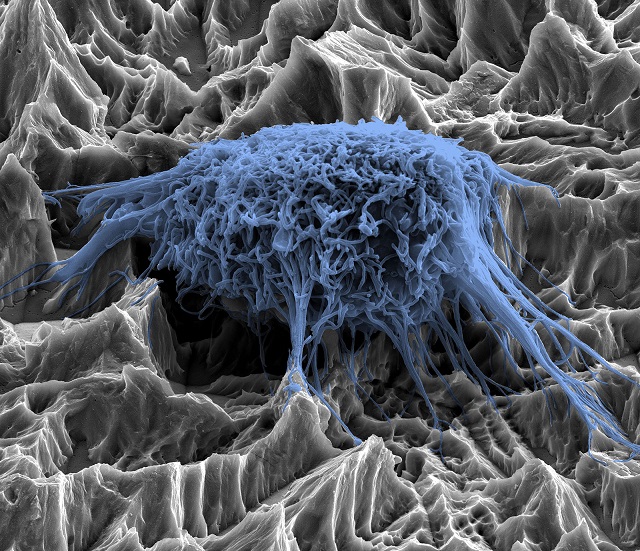A unique plasma implant coating, DentaPlas, has been developed that uses silver nanoparticles to prevent infection of dental implants. The dentaplas technology is as robust as conventional implants yet has a greater lifetime.
 A scanning electron microscope image shows a cell on a dental implant. (© Fraunhofer IFAM)
A scanning electron microscope image shows a cell on a dental implant. (© Fraunhofer IFAM)
A major complication of dental implants is bacterial infections which can lead to degeneration of the jawbone. This latest development can prevent or reduce the risk of future infections, enhancing implact effectiveness in the long term.
Germany has a record number of dental implants, totaling to approximately one million per annum. However, it is necessary to replace these implants because of bacterial infections in tissues. Whenever an artificial dental root is implanted, the body’s cellular defenses must defend itself against infectious microorganisms. In cases where the bacteria succesfully bypass this immune system, they quickly create a biological film over the titanium implant which protects them from future antibiotics. When germs subsequently invade the implant, an inflammatory response is triggered which results in bone degradation.
The new plasma coating not only inhibits bacterial growth, but also enables the implant to rapidly form a longer lasting bond with the jawbone. This adhesion was accomplished by integrating silver nanoparticles onto the implacts surface. The nanoparticles were combined with the plasma polymer coating, which has a thickness of just 100 nm, and the were allowed to dissolve over a span of few weeks. During this period, small amounts of anti-microbial silver ions were continuously released by the nanoparticles that killed any bacteria present.
During trial experiments unitizing titanium test samples and finished implants, it was shown that the DentaPlas implant coating can be easily sterilized and features anti-microbial properties whilst still being biocompatible. The researchers coated the test samples at IFAM’s plasma polymerization facility and then tested the robustness and mechanical stability of the DentaPlas implant coating. With the help of instruments used in current dental practices, the DentaPlas coated implants were fixed into place.
We have given the DentaPlas coating a rough texture, which promotes cellular growth, in addition to combining it with a hydrophilic plasma polymer coating, which attracts moisture.
Dr. Ingo Grunwald - Project Manager
The DentaPlas system consists of three layers, with two plasma polymer layers surrounding a center layer of silver. Within this structure a biocide reservoir is formed, and the outermost layer releases the ions. This is beneficial because it prevents direct contact between the tissue and the silver particles, which can be toxic when exposed.
Dr. Dirk Salz - Developer
The thickness and porosity of the layers as well as the silver concentration can be customized. This enables the silver ions to enter the outermost layer of the plasma polymer over the specified time required to infiltrate the implant. Once the silver reservoir has been depleted silver ions will no longer be emitted. This behaviour means the nanoparticles will not result in any toxic effects over time. The prototype of the plasma polymer coating is now available.